This section describes the archaeology and prehistory of the Northeast Creek basin, based on the few artifacts collected and what has been discovered about nearby sites. The organization of this section is chronological, based on the styles of archeological artifacts. So far, Northeast Creek Streamwatch knows of only a few artifacts that definitely come from the Northeast Creeek basin. No doubt there are many other artifacts from the Northeast Creek basin in private collections of which people know very little about them except “my grandfather collected arrowheads and pottery from the field when he was plowing.”
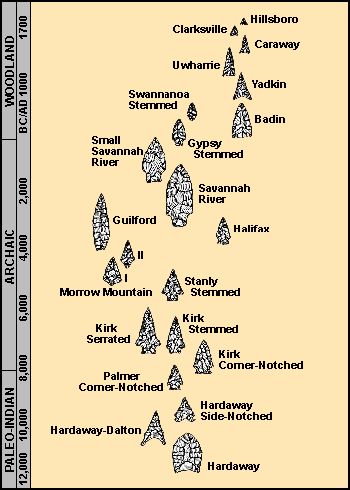
Paleo-Indian (9500 BC – 8000 BC)
There have been Paleo-Indian points found in the northern Piedmont. Because of all the private collections of points (“arrowheads”) that residents of the Northeast Creek basin have accumulated over the years, we don’t know whether people during the Paleo-Indian period inhabited or even just wandered into the Northeast Creek basin in search of game or gathering seeds and nuts.
This period marks the change in the climate as the glaciers last receded from the Great Lakes area and the spruce and jack pine boreal forests gave way to forests of oak, elm, hickory, beech, and birch. This was the period in which mastodons, mammoths, and the early horses were becoming extinct. Because of the humidity in this area, there likely are few bones preserved that tell whether any of the early mammals existed or whether the Early Paleo-Indian people hunted them as game. Subsistence was probably by hunting deer and small mammals, and gathering acorns, hickory nuts, and seeds.
The people were likely organized in nomadic bands but never wandering far from outcrops of rock that could be used to make stone tools. We know that people during the Paleo-Indian period quarried rhyolite in the Uwharrie Mountains of Randolph, Montgomery, and Stanly counties. And Paleo-Indian points were found in the lowest levels of the Haw River site studied before Lake Jordan was flooded.
By 7000 BC, the change in the climate was complete and the forests now included sweet gum, chestnut, red maple, and tupelo gum.
Early Archaic (8000 BC – 6000 BC)
During the Early Archaic period, the nomadic bands became familiar with their environment and started specializing within a particular geographical area. Hunting deer probably provided meat, and acorns and hickory nuts were the major focus of gathering. In the Paleo-Indian period, people made tools other than points from an available rock; in the Early Archaic, people began making specialized scraping and cutting tools for working animal skins into clothing and containers. They also made adzes, drills, or gravers to help in working wood or bones. And they used fist-sized river cobbles as hammers and anvils. They could have lived in small (50-150 person) bands that range over a single drainage system and specializing in what was available there, or they could have still have ranged across multiple drainage systems never getting too far away from the tool quarries in the Uwharrie Mountains.
Middle Archaic (6000 BC – 3000 BC)
Two Middle Archaic material cultures are found in the Northeast Creek basin: Morrow Mountain phase and Guilford phase. During the Middle Archaic period, inventions like the spear-thrower (atlatl) and chipped stone axes became useful tools. Scraping and cutting used stone flakes that show very little sharpening or shaping. Tools are found at temporary encampments, which could be anywhere in the landscape. The people most likely had favored sites for encampment, and these tended to be scattered out more in flood plains than between streams. Small kinship groups might have moved as a unit in relatively stable and regular movements to find food and other resources.
Morrow Mountain Phase (5000 BC – 4000 BC)
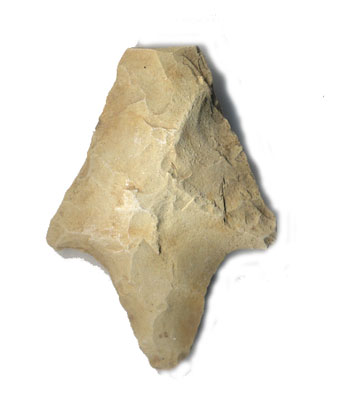
The design of Morrow Mountain phase points have a generally triangular stem and triangular point. They seem to represent a style that persisted alongside other Middle Archaic phases of points, such as Stanly, Guilford, and Halifax phases.
Guilford Phase (4000 BC – 3000 BC)
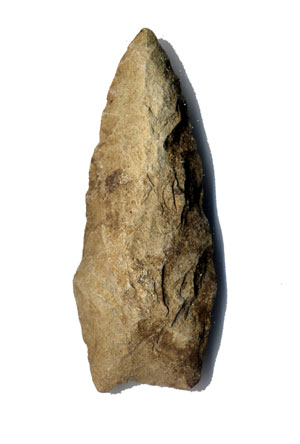
Guilford phase points have a shape like that of European lances (lanceolate form); this shape is like that of the leaf of a peach tree.
Late Archaic (3000 BC – 1000 BC)
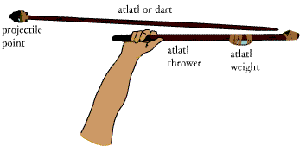
During the Late Archaic period, populations increased because of the generally improving climate and the gradual trend for encampments to be inhabited for longer periods of time. Even toward the end of the period tending toward permanent settlements.
Late Archaic period spearpoints appear to have been multi-purpose cutting tools as well. They start large and through resharpening over time become smaller. Late Archaic period tools also include hammerstones for picking and grinding granite rocks into axes. Axes of the Late Archaic period have grooves for hafting (attaching handles). In addition, there were scrapers, drills, and other chipped stone tools as well as polished stones used as weights for atlatls (spear-throwing sticks). The people of the Late Archaic used stone mortars to grind seeds and nuts. And numerous stone net sinker indicate that fishing was a source of food. Used during the latter half of the Lat Archaic period, soapstone bowls became used for cooking by placing them directly on the fire.
Savannah River Phase (3000 BC – 1000 BC)
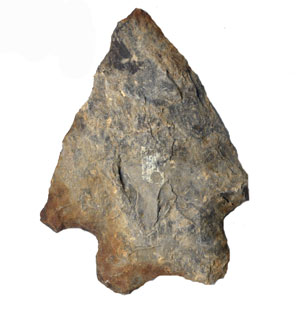
During the Savannah River phase, spearpoints had broad stems, and the phase was widely distributed over the East Coast; Savannah River points are found from New York to Florida.
People during the Savannah River phase regularly hunted white-tail deer, bear, and small mammals. They began growing squash and gourds after 2000 BC and selectively harvested sunflowers, maygrass, and goosefoot; this selective harvesting was the beginnings of cultivation. Along streams, they caught fish, turtles, migratory waterfowl, and freshwater mussels, all of which were seasonal. Acorns, hickory nuts, wild fruits, berries were gathered in season. Areas rich in these resources soon became sites of more permanent settlement.
For most of this phase, people cooked in hide containers, gourds, and baskets, set on perforated flat stones near the fire. Toward the end of this phase, peoples along the coasts of South Carolina and Florida invented pottery, a technology that spread throughout the East Coast by the end of the Late Archaic period.
The Northeast Creek basin during this period seems to have been a hunting area; settlements outside the Northeast Creek basin that might have used the Northeast Creek basin landscape as hunting grounds have been found on New Hope Creek (now under Lake Jordan) and on the Haw River.
Early and Middle Woodland Period (1000 BC – AD 800)
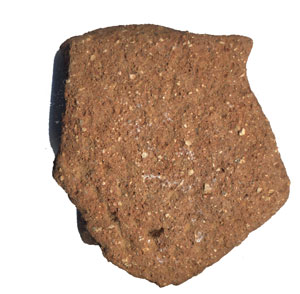
Three things mark the division between the Archaic period and the Woodland Period: pottery-making, more permanent villages, and the farming of plants. These aspects of culture seem to have evolved without significant outside influences, such the mound building culture. As a result small settlements could be scattered up tributaries, such as Northeast Creek, using areas near floodplains for settlement and the floodplains for agriculture. The presence of pottery at certain floodplains in the Northeast Creek basin might indicate a few very small settlements, likely to have lasted only a short period of time.
During the Woodland period, people domesticated: knotweed, sumpweed, squash, bottle gourds, sunflowers, maygrass and goosefoot. These were planted in the fertile and friable alluvial soils of floodplains. As agriculture developed, settlements became larger, particularly after corn agriculture spread to the Piedmont. Nonetheless, hunting and gathering continued to be a significant activity in providing food.
Corn agriculture used hoes as tools and created Indian “old fields” later identified on early maps. These fields comprised small hills of earth that supported the growing of the “Three Sisters” — cofn (Zea mays), beans (Phaseolus vulgaris), and squash (Cucurbita pepo). The corn supported the beans. The beans, being legumes, fix nitrogen in the soil. The squash cover the hill as a “green mulch”, reducing competition from other plants, including weeds.
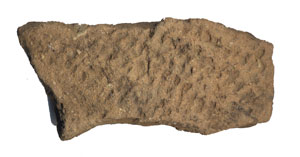
As agriculture developed, people started burying the dead in simple pits with a few belongings within their house or nearby. What distinctions there were in the few belongings that were buried with them were related to age and sex.
The society during the Woodland period held together as a result of a web of kinship ties. The societies were egalitarian, with leadership achieved rather than ascribed.
Badin Phase (circa 500 BC)
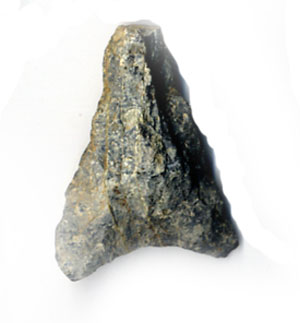
The pottery of the Badin phase is early pottery in the Piedmont. The clay used in the pots was tempered with sand. The potters stacked rings of clay and welded the rings together using a cord-wrapped paddle. The jars have straight sides and conical bases. The style and construction of the jars are similar to earlier pottery found at Deep Creek in coastal North Carolina.
Points from the Badin phase are crude triangles. A later cultural phase, the Yadkin phase, refined the style of triangular points by finely flaking the edges.
The presence of fire hearths at some sites that have Badin phase artifacts indicates that settlement became more permanent. These sites are associated with large amounts of pottery and animal bones and seem to indicate the beginning of concentration of populations into larger, more permanent villages. In these settlements, later phases of artifacts appear—the Haw River phase (385 BC – 195 BC) and the Yadkin phase (290 BC – AD 60). Archaeologist believe these to be further evolution of Badin phase culture.
During the Early and Middle Woodland periods, hunters replaced the use of the atlatl with the use of the bow and arrow.
In addition to game, the people cultivated maygrass, knotweed, goosefoot, and sunflowers and continued to gather acorns, hickory nuts, and river mussels.
Late Woodland Period (AD 800 – AD 1600)
Between AD 800 and AD 1200, settled villages near the Uwharrie Mountains of Randolph, Montgomery, and Stanly counties were involved in hunting, gathering, and garden crops. Corn became an important crops toward the end of this time. More established settlements constructed large storage pits for food. Burial was in oval pits, with the body flexed and sometimes adorned with shell beads; some villages located cemeteries away from houses.
Between AD 1000 and AD 1600, in the area of the Haw River phase settlement was in dispersed households along ridges and knolls bordering floodplains. People dug cylindrical storage pits and filled them with soil and refuse when they were not longer used for storage. Items found in these storage pits indicate that the diet was reliant of corn agriculture, beans, squash, and sunflower seeds; there were charred fragments of acorns and hickory nuts, and evidence that deer, squirrel, and rabbit were wild food sources.
Toward the end of this time there was consolidation of population into large villages, surrounded by stockades. As population increased because of the better diet from agriculture, competition for agricultural land brought villages into conflict. But hunting and gathering continued, and most artifacts in the Northeast Creek basin from the Late Woodland period are likely to be points. At the end of this period, the people are the ancestors of the Eno, Occaneechi, Shakori, and Sissipahaw people first encountered in the Contact period.
Contact Period (AD 1600 – AD 1750)
The earliest evidence in the Haw River valley of contact with Europeans is a site in northern Chatham County, which was abandoned prior to AD 1700. The houses were oval-shaped, most likely domed wigwams, 18 feet by 24 feet in size. In this reference “wigwam” is the terminology for domed dwellings applied by Europeans and based on similar terms used by Northeastern Algonquian indigenous peoples. We do not know and have no documentary evidence for what local indigenous people called their dwellings. Finally, what indicates it to be from the Contact period are the glass trade beads and brass ornaments of the burials.
The pottery at this site used sand and crushed feldspar for tempering; the jars were smooth and simple-stamped.
Prior to 1700, there were limited English goods coming into this area, primarily through indirect trade networks. But one of the items that arrived was peaches.
In 1676, Bacon’s Rebellion in Virginia started migrations of peoples from along the Roanoke River as Fort Christianna was established. Settlement of the Piedmont of North Carolina from Virginia did not begin until Fort Christianna was decommissioned in 1732. From then, it took until 1744 and the descent of the title Earl Granville to John Carteret before land grants started to be sold in North Carolina and until around 1750 that land grants in the area of the Northeast Creek basin began to be filed. There is likely some undocumented trading in the area or squatting on land that occurred near the Trading Path, but the difficulty of transportation in the Triassic Basin forests and wetlands of the Northeast Creek basin likely made it unsettled informally for some time, possibly up until the first land grants.
